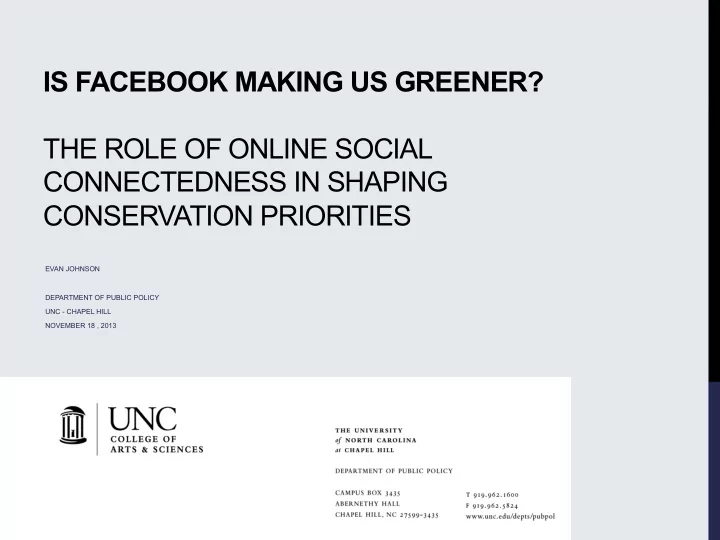

IS FACEBOOK MAKING US GREENER? THE ROLE OF ONLINE SOCIAL CONNECTEDNESS IN SHAPING CONSERVATION PRIORITIES EVAN JOHNSON DEPARTMENT OF PUBLIC POLICY UNC - CHAPEL HILL NOVEMBER 18 , 2013
BACKGROUND AND MOTIVATION external versus internal barriers: • consumers face significant social and psychological barriers to behavioral change. social capital as a source of internal motivation and transactions costs associated with connecting with and learning from others Illustrates a need for policy research to examine the effects of social connectedness on conservation priorities, practices, and appliance- specific energy behaviors.
THEORETICAL MODEL Value-belief-norm theory: • environmental attitudes result from the activation of norms and values within the constraints of contextual features such as socioeconomic status, resources, technologies, and social interactions (Stern 2000) • Online social networking allows for greater information access, connectedness accountability that is likely to foster conservation attitudes and practices that are less likely under offline conditions Development of Conservation Technological Exposure to pro- conservation and efficiency and Social environmental attitudes and investment Context norms and beliefs priorities behaviors
EMPIRICAL MODEL Hypothesis 1 : heavy users of social networking web sites will place higher degrees of importance on environmental priorities than non-heavy- users and will engage more frequently in conservation practices Prob(Y| λ ) = e - λ µ ( λ i µ i ) yi / y Examines the probability of a consumer prioritizing environmental protection and renewable energy Predicts the extent of environmental prioritization through count data analysis
EMPIRICAL MODEL Hypothesis 2 : respondents who value environmental protection will consume less energy than similar respondents who are not environmentally motivated Y energy behavior = α + β green-priorities + β demographic controls + β housing characteristics + µ
DATA Electric utility consumer segmentation survey 10-page questionnaire to 16,500 residential customers: 38% response 68 questions: Housing characteristics, home appliance use, heating, cooling, income, education Detailed value statements : Likert scale attitudinal measures and 1-10 priority sticker placements Behavioral variables: • Annual and monthly billing data • Taken steps to conserve? • Replaced light bulbs with CFLs?
KEY VARIABLES Y 1 = count of stickers (0 -10) allocated to environmental protection and energy conservation relative to other priorities (cost savings, comfort, energy security, etc.) Y 2 = energy consumption and conservation behavior X = Treatment = “Heavy” exposure to online communities and social networking activities • Ordinal measures of internet use, Facebook, Twitter
KEY ATTITUDINAL DIFFERENCES AMONG CONSUMER SEGMENTS
DO RESIDENTIAL CONSUMERS CARE ABOUT RENEWABLE ENERGY? Counts of Pro-Renewable Energy Stickers .8 .6 Average 1.4 stickers out of 10 Density .4 .2 Versus 1.6 (comfort) and 3.8 (cost) 0 .5 1 1.5 2 2.5 3 Predicted number of events 18-24 year-olds place lowest priority on renewable energy solutions 25-34 year-olds demonstrate highest priority
ATTITUDINAL RESULTS • Treatment group more strongly associated with pro-environmental attitudes than with competing values such as cost savings and comfort. • On average a Treatment group member places . 132 increase more stickers on renewable energy priorities relative to less frequent users. • MLE models illustrate that the heavy web use treatment corresponds to a 1.83 percentage point decrease in placing a low priority on conservation. Effects are modest, but promising given their influence relative to other priorities such as cost and comfort
PERCENTAGE OF ONLINE TREATMENT AND CONTROL GROUPS EXHIBITING PRO-ENVIRONMENTAL ATTITUDES 20.5 20 20 19.5 19.5 19 18.5 17.7 18 17.5 17 17 16.5 16 15.5 Online network Control Online network Control treatment treatment Environmental Protection is is very Renewable energy is very important important
PERCENTAGE OF ONLINE TREATMENT AND CONTROL GROUPS EXHIBITING PRO-ENVIRONMENTAL BEHAVIORS 90 77.7 76.1 80 70 56.7 60 47.3 50 40 30 20 10 0 Online network Control Online network Control treatment treatment Taken action to conserve Replaced most bulbs with CFLs
BEHAVIORAL RESULTS Are “Green” Consumers Practicing what they preach? Each additional point assigned to green priorities is associated with 2.4% decrease in annual electricity expenditure and higher levels of participation in conservation activities “Greens” show a 2.75 percentage point increase in probability of replacing most or all bulbs with CFLs or LEDs “Heavy web users” show a 4.2 percentage point increase
DISCUSSION How to interpret these effects? • Unobserved features of internet users are inseparable from the causal impact of the treatment • May be that many high web users care less about the environment since the behavior itself results in energy use • Limitations of the data set and measurement error associated with using sticker counts across competing priorities as a true indicator of environmental belief • Need better network and behavioral data to operationalize social capital and detect exposure to social norms, information, and peer feedback online
FUTURE WORK • Development of a predictive tool, assigning precise likelihoods of adoption and prioritization to disaggregated consumer groups • Quasi-experimental approaches – instrumental variable methods already show that heavy users users are 30% more likely to have replaced incandescents with CFLs • Experiments to test the impact of exposure to novel online networking platforms on attitudes and subsequent behavior
THANKS EVAN JOHNSON EVANEJ@LIVE.UNC.EDU
REFERENCES
Recommend
More recommend